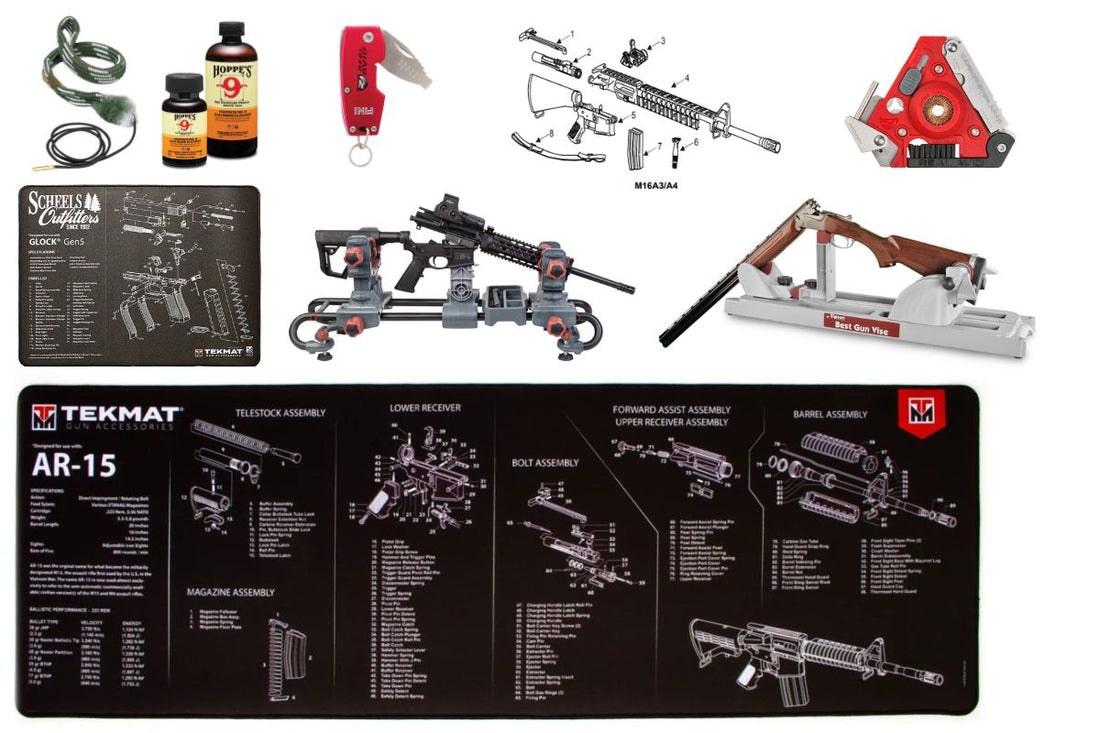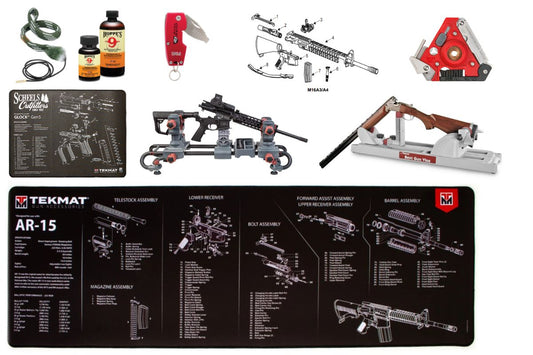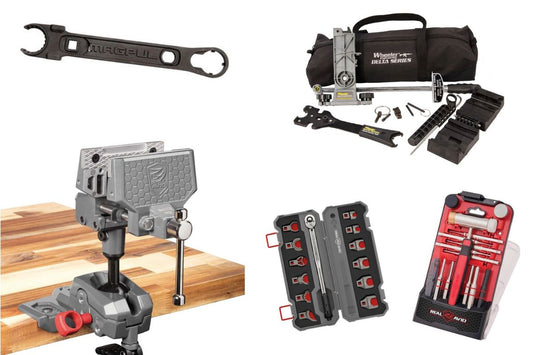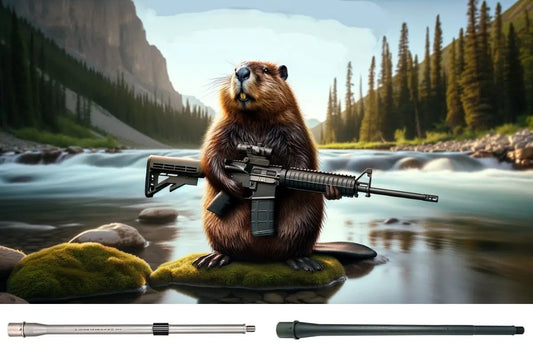
Clean Enough to Trust: Exactly How Often to Clean Your Handgun, AR-15, and Shotgun
TL;DR for Skimmers
- Clean handgun after every session or ~250–300 rounds; monthly deep clean if it’s your EDC.
- Clean AR-15 after each trip or 500–1,000 rounds; lube generously—the AR runs better wet.
- Shotguns: clean every hunt/target day; 100–200 rounds for semi-autos; sooner after moisture/dirt.
- Use quality solvents/CLP, chamber/BCG tools, and store with dehumidifiers to prevent rust.
- Specific, high-quality gear linked below from SCHEELS.
|
Platform |
Clean After… |
Typical Round Count Rule |
“Deeper” Clean |
Lube Notes |
Environments That Demand Sooner Cleaning |
|
Handgun (carry or range) |
Every range session |
~250–300 rounds |
Monthly if carried daily (even unfired) |
Light film on rails/barrel hood; don’t over-oil |
Rain, sweat/humidity, fine dust, pocket/lint from carry |
|
AR-15 |
Each range trip |
500–1,000 rounds (modern ARs tolerate fouling if lubricated) |
Before a match/course or if reliability dips |
“Runs better wet than dry” on the BCG |
Sandy/alkaline dust, suppressed use, steel/dirty ammo |
|
Shotgun |
After hunts or target days |
100–200 rounds for semi-autos; pumps can go longer |
After exposure to water/mud; seasonal deep clean |
Focus on gas system (semis), light oil on action/hinge |
Wet weather, salt spray, mud, plant chaff |
Why “how often” isn’t one number
Frequency depends on (1) round count, (2) environment (wet/salty or dusty = sooner), (3) ammo (dirty powders, steel-cased), (4) use case (defensive vs. casual), and (5) platform design (gas vs. inertia/pump). The general cadence above keeps reliability high without wasting time obsessing over spotless parts.
Expert note from GLOCK: “Proper cleaning and lubrication prevents corrosion and removes accumulated dirt and debris that can affect your pistol’s operation.”
AR-15 reality (Pat Rogers via S.W.A.T. Magazine/Slip 2000): “The AR series runs significantly better wet than dry.”
Shotgun OEM guidance (Remington V3 manual): “After each use, follow the lubrication and maintenance directions… If the firearm is immersed in water, it must be thoroughly cleaned and lubricated as soon as possible.” – remarms.com
Handgun: the 250–300-round rule (and a fast post-range routine)
When to clean
- After every shooting session or about every 250–300 rounds, whichever comes first.
- Monthly field-strip if it’s your EDC even if unfired (carry guns accumulate sweat, lint, skin oils).
What “good enough” looks like (5–10 minutes)
- Unload and verify clear; keep muzzle in a safe direction.
- Bore: One pass with a caliber-correct BoreSnake or rod/patches with a classic solvent like Hoppe’s No. 9.
- Action/slide: Wipe carbon, then a measured film of oil on rails, barrel exterior/hood, locking surfaces.
- Final: Wipe exterior with a silicone cloth to remove prints and leave a corrosion-inhibiting film.
Best-in-class tools available at SCHEELS
- Solvent: Hoppe’s No. 9 Cleaning Solvent — reliable classic for bore fouling.
- All-in-one CLP: Break-Free CLP (aerosol or bottle) — cleans, lubricates, protects; MIL-L-63460 lineage. Also consider: Break-Free CLP Lube Cleaner
- Bore quick-clean: Hoppe’s BoreSnake in your caliber (e.g., 9mm).
- Bench protection: Pistol cleaning mat with parts tray (e.g., 1911 Smart Mat) or TekMat.
- Final wipe: Silicone Cleaning Cloth.
Pros & cons of cleaning handguns this often
- Pros: Maximizes reliability for carry guns; prevents rust from sweat; faster because fouling never cakes.
- Cons: Over-cleaning with aggressive solvents can strip protective oils; over-lubing can attract lint.
What the experts say
- GLOCK’s guidance reinforces moderation in lubrication and field-strip each cleaning—sound practice across brands.
AR-15: “Wet and ready” beats “white-glove clean”
When to clean
- Each range trip or every 500–1,000 rounds—modern ARs tolerate fouling if they’re well-lubricated.
- Before matches/courses or when reliability declines (short-stroking, sluggish lockback), do a deeper BCG/chamber clean.
Minimum viable post-range
- Unload / clear, separate upper and lower.
- Bolt Carrier Group (BCG): Wipe carbon from bolt tail, lugs, carrier rails, and gas rings.
- Chamber & extension lugs: Use a star-chamber brush and patches.
- Bore: Pull-through cable or rod with solvent, then dry patch.
- Lube: Generous oil on BCG rails, cam pin, bolt lugs/outer body. Don’t fear a “wet” BCG.
“The AR series runs significantly better wet than dry…” — Pat Rogers, via S.W.A.T./Slip 2000.
Upgrade your AR cleaning kit at SCHEELS
-
Carbon tools:
• Real Avid AR15 Scraper—targets 12 critical BCG surfaces.
• Real Avid Carbon Boss AR15—multi-tool with brushes and cotter pin puller.
• Real Avid AR15 Tool—folding multi-tool for cleaning and emergency fixes. - Platform kits: Otis MSR/AR 5.56 Breech-to-Muzzle kit.
- Mats & vises: Oversized AR-15 TekMat; Tipton Best Gun Vise for stability.
- Lube & CLP: Break-Free CLP (MIL-spec heritage) for field cleaning & rust inhibition.
Pros & cons of the “wet BCG, routine clean” approach
- Pros: Highest reliability in carbine classes; avoids time-sink of obsessive cleaning; protects in harsh environments.
- Cons: Wet guns sling some oil; dust can stick to excess lube (wipe exterior), and suppressed guns will need more frequent wipe-downs.
Deeper cut (for the data-minded)
- U.S. mil TM 9-1005-319-10 details AR lubrication/maintenance and reinforce that operational reliability is a function of lubrication more than spotless parts.
Shotguns: clean after the field, and sooner if it gets wet
When to clean
- After every hunt or target outing (mud, chaff, and moisture are the enemies).
- Semi-autos: about every 100–200 rounds; keep gas systems clean.
- Pumps: can go longer, but a post-use wipe/boresnake prevents corrosion and sticky actions.
If it’s wet: Strip the forearm and barrel, dry thoroughly, re-oil metal, and address choke tubes so they don’t seize.
OEM reminder (Remington V3 manual): After each use, clean and lubricate; if immersed in water—especially salt—flush, dry, clean, and lube ASAP.
Shotgun-specific gear that actually helps
- 12-ga kit: Otis Patriot 12-ga breech-to-muzzle set.
-
Bore brushes:
• SCHEELS Outfitters Bronze Shotgun Bore Brush (robust bristles).
• Tornado spiral-wound bore brush for stubborn plastic/lead streaking. -
Choke tube care:
• Carlson’s T-Handle choke wrench for stuck tubes.
• FINI universal choke wrench—tiny, lives on your keychain/range bag. - Bench helpers: Tipton Best Gun Vise or Ultra Gun Vise for stable shotgun work.
Pros & cons of this cadence
- Pros: Prevents choke tube galling; avoids gas piston/cup fouling that causes short-stroking; rust prevention after damp hunts.
- Cons: Gas systems can tempt over-cleaning with abrasives—use nylon/bronze, not steel tools; don’t flood wood stocks with oil.
Ammo, environment & suppressors: when to clean sooner
- Dirty powders / bargain bulk ammo: Expect more unburned powder and soot—clean earlier than the round-count rules.
- Steel-cased & lacquered coatings: Extra chamber/brass-deflector fouling on ARs; check the chamber more often.
- Suppressors: Blow much more particulate back into the action; plan AR-15 mini-cleans every 300–500 rounds and a wet BCG.
- Wet/salty/dusty conditions: Treat rain/salt spray as a “clean now” event, and desert dust as “wipe and re-lube today.”
- Carry conditions: Pocket/appendix carry collects lint and sweat salts—monthly field-strip even if you didn’t shoot.
What a sensible deep-clean looks like (per platform)
Handgun (monthly for EDC, or every few sessions otherwise)
- Field strip, scrub bore with solvent until patches come out light gray to white, de-carbon breechface/extractor hook, clean rails, very lightly oil—one drop per rail, one on barrel exterior/hood, a film on exterior metal. GLOCK specifically cautions against over-lubing; apply only where specified. – GLOCK
AR-15 (pre-match or when reliability dips)
- Strip BCG; scrape bolt tail and under extractor, clean gas key exterior, swab carrier, chamber star brush and patches in the extension, clean buffer face/tube of grit, re-lube BCG rails, cam pin, bolt body, lugs. The goal isn’t “white glove,” it’s smooth cycling + corrosion control. Slip 2000’s summary of Pat Rogers’ classes supports the “wet BCG” emphasis. – Slip2000.com
Shotgun (after muddy/rainy hunts or every few outings)
- Pull the barrel, remove and clean choke tube, apply a whisper of choke tube grease or light oil to threads, run bronze brush/patches, clean action rails/bolt face, inspect gas pistons (semis), lubricate hinge pin/locking surfaces (O/Us). Remington’s OEM guidance to clean after each use—and ASAP after water exposure—is a conservative but smart baseline. – remarms.com
Storage & rust prevention: cheap insurance that saves cleaning time
-
Inside the safe: Use a dehumidifier rod or rechargeable silica to prevent condensation and slow flash rust.
• Lockdown GunSaver 18" Dehumidifier rod.
• Lockdown Silica Gel Can (rechargeable).
• Lockdown Dehumidifier Rod options, or Hornady/SnapSafe versions. - Post-clean wipe: Scheels Silicone cloth finishes remove salts and fingerprints that seed rust.
Product alternatives & bundles available at SCHEELS
- Universal kits: Hoppe’s Universal Cleaning Accessory Kit—rods/brushes for handgun/rifle/shotgun.
-
Category hubs:
• Bore Snakes (all calibers/gauges).
• Gun Cleaning Kits (brand selection).
• Gun Vises & Mats to keep parts organized.
Common pitfalls (and how to avoid them)
- Over-cleaning the AR gas system with abrasives—don’t “polish” the gas port or inside the gas key; you’ll do more harm than good. Stick to solvent, nylon/bronze, and functional carbon removal on the BCG.
- Under-lubing the AR BCG—a dry BCG is a stoppage waiting to happen, especially with weak ammo or when suppressed. Keep it wet. – Slip2000.com
- Soaking striker-fired pistol channels—keep oil/solvent out of the striker channel to avoid light primer strikes (follow your OEM’s lube points).
- Ignoring choke tubes—remove, clean, and lightly oil threads after wet hunts; stuck chokes are a gunsmith bill.
- Skipping storage humidity control—for most rust issues, dehumidification fixes the root cause.
- Using household degreasers on camo/wood finishes—they can stain/soften; use gun-safe products and wipe promptly.
- Too much oil on shotguns—especially in cold; light films beat syrupy actions.
Final, practical cadence you can live with
If you want a simple rule set that covers 95% of shooters:
- Handgun: Clean each session or ~250–300 rounds; monthly for EDC even if unfired.
- AR-15: Lube before/during range days; clean each trip or ~500–1,000 rounds; keep the BCG wet.
- Shotgun: Clean after every hunt/target day; every 100–200 rounds for semi-autos; sooner after moisture/dirt.
- Any gun that got wet/dirty: Clean now, not “next weekend.” (Remington’s manuals explicitly say ASAP after water.)
One-bag maintenance essentials (our short list)
- Solvent + CLP (Hoppe’s No. 9 + Break-Free CLP).
- Pull-through bore cleaner (BoreSnake) + caliber/gauge brushes.
- AR-15 carbon scraper or Carbon Boss for BCG hotspots.
- Gun mat with parts tray and a vise if you bench clean.
- Silicone cloth for final wipe and a dehumidifier in the safe.
A note on “clean vs. lube” (why we’re opinionated about it)
We prioritize reliability over cosmetic cleanliness. On ARs in particular, we’d rather see visible oil on a slightly dirty BCG than a bone-dry, gleaming carrier. That’s not contrarian; it’s based on thousands of class guns observed by instructors like Pat Rogers, who famously pushed the “wet” approach because it keeps carbines running. – Slip2000.com
For pistols and shotguns, the calculus is similar, but since they tend to be carried close to the body or run in wet fields, corrosion control and post-use wipe-downs matter as much as function. That’s why we like a quick BoreSnake + CLP + silicone cloth routine you’ll actually do every time.
Safety that’s crucial and non-obvious
- Striker channels & firing pin tunnels: keep dry. Oil migrates and can deaden primers (pistols) or collect gunk (AR firing pin channel). Follow OEM lube diagrams—less is more here.
- Solvent splash + optics: aggressive cleaners can creep into red-dot emitter bays or under glass. Keep optics covered or off the gun during heavy solvent work.
- Ammonia & copper solvents: great for heavy fouling, but don’t soak aluminum receivers forever; follow dwell times.
- Choke tubes: if you shot in rain/salt air, remove and oil before storage to avoid “welded” chokes.
Shop all recommended cleaning gear → SCHEELS.com.




